|
X-ray Photon Correlation Spectroscopy
(XPCS) Studies of Liquid Surface Dynamics |
|
|
X-ray photon
correlation spectroscopy (XPCS) is the X-ray analog of
Dynamical
Light Scattering (DLS) and is a relatively new technique which uses
coherent X-ray beams to study the dynamics of liquids on time
scales from seconds down to microseconds and length scales from
microns to nanometers. |
|
|
|
XPCS principles |
|
| The method relies on
the fact that a particular arrangement of atoms in a sample
produces a characteristic "speckle" pattern when it scatters a
coherent beam of X-rays. If the arrangement of atoms changes,
the speckle pattern changes, and by studying these changes as a
function of time, one can obtain information at the atomic
dynamics at various wavevector transfer (i.e. at different
length scales). |
|
| For example,
let's consider the Brownian motion of 100 particles. The
simulated scattering pattern is calculated through the Fourier
transform of the instantaneous positions of these particles. |
|
|
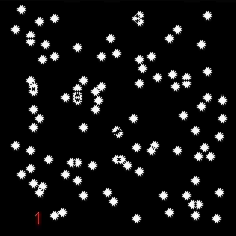
MOVIE: 2D
Brownian Motion of 100 particles |
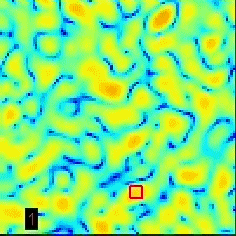
MOVIE:
Portion of the scattering pattern |
|
| The
intensity at an interested region (red box) in the reciprocal
space varies in a random-like way as the absolute time elapses. |
|
|
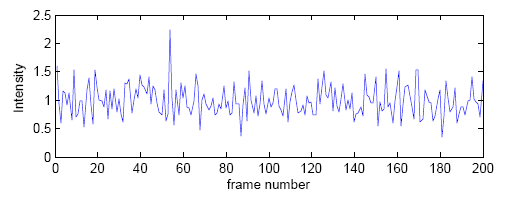
FIG:
Random-like intensity variations |
|
| However, if
an intensity-intensity auto-correlation is performed as a
function of time delay (frame delay here), the characteristic of
the dynamics, which is basically the diffusion coefficient for
Brownian motion, can be revealed. |
|
|
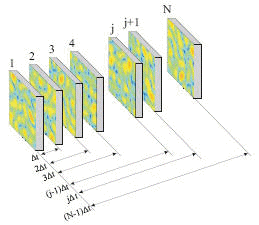
FIG:
Protocol for auto-correlation |

FIG:
Intensity-intensity auto-correlation function |
|
| As an
extension of DLS, XPCS has an ability to study the dynamics on a
much smaller length scale than can be achieved by traditional
DLS and on a slower time scale than the
neutron spin-echo (NSE)
technique can usually reach. It allows a study of samples that
are opaque to visible light, and the broadening problem of the
wave vector due to multiple scattering in DLS can be solved. The
following figure shows the frequency and wave vector ranges
accessible to XPCS compared with other frequently used
techniques for the study of dynamics. |
|
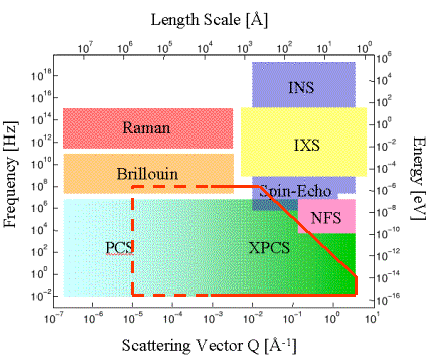
FIG:
Frequency-scattering vector space covered by XPCS and
complementary techniques: photon correlation spectroscopy with
visible coherent light (PCS), Raman and Brillouin Scattering,
inelastic neutron (INS) and x-ray scattering (IXS), neutron
spin-echo and nuclear forward scattering (NFS). Reprinted from [Correlation
spectroscopy with coherent x-rays by G.
Grubel and F. Zontone, J. Alloys Compd. 362, 3 (2004).
DOI: 0.1016/S0925-8388(03)00555-3]. |
|
To top |
|
|
| Dynamics of Entangled Polymer Melts Using Gold Nanoparticles as Probes |
|
|
Polymer nanocomposites (PNC) are attractive materials which consist of a polymer or copolymer having nanoparticles or nanofillers dispersed in the polymer matrix. These nanoparticles can be of different shape (e.g., platelets, fibers, spheroids), or type (e.g., metal, silicon, carbon nanotubes, Graphene). Besides the abnormal physical and chemical properties of PNCs due to the small size of the nanometer-scale particles, which have been widely studied with many systems, the nanoparticles can also serve as probes of the nanometer-scale mechanical properties of the polymer. Several successful attempts to study the mobility of nanoparticles with XPCS have been conducted at 8 ID, APS recently. In those studies, the motion of nanometer-scale gold particles within polystyrene (PS) melts and solutions were studied. The surfaces of the particles are functionalized with short chain PS to stabilize them against aggregation. We were conducting a similar study but with different gold nanoparticles, with coatings of PS chains longer than the entanglement length. Thus, the motion of the gold particles cannot be simply treated as due to the thermal fluctuations of the particles themselves but may reflect the entanglement effects of the polymer matrix. Preliminary measurements have revealed intriguing and unexpected results for the particle dynamics after the PS was heated up to 170 C, about 70 C higher than the glass transition temperature, Tg. Specifically, the dynamics changed from overdamped behavior to underdamped oscillatory behavior. Clarification of the nature of this crossover could significantly impact our understanding of the nanoscale dynamics of entangled polymers, particularly in the context of nanocomposites. We collaborated with Zhang Jiang, Suresh Narayanan, Hyunjun Kim and Thomas Russell on this project.
|
|
To top |
|
| More on XPCS |
|
|
Here are some short
lectures on XPCS: |
|
|
|
To top |
|
|
 |
| |
|
|
